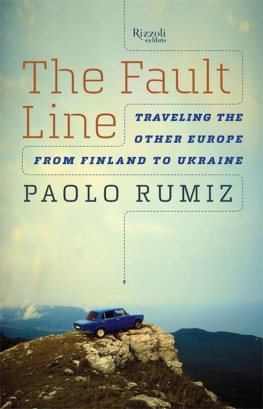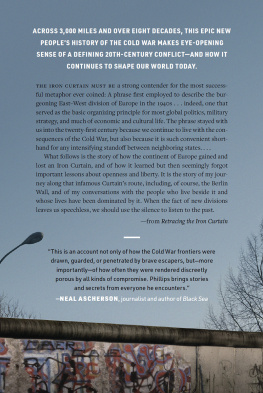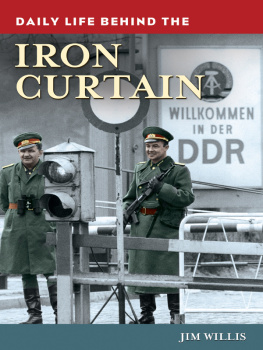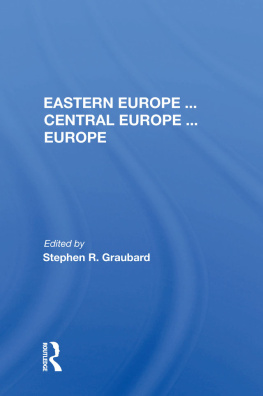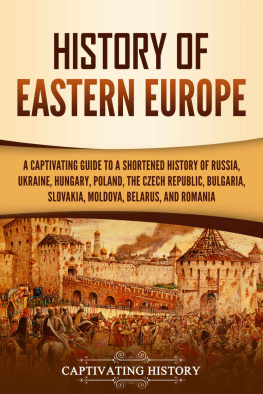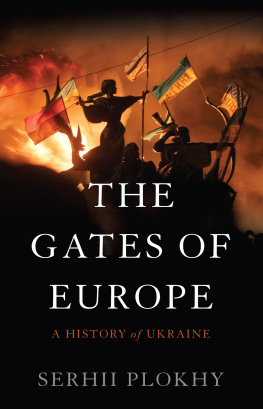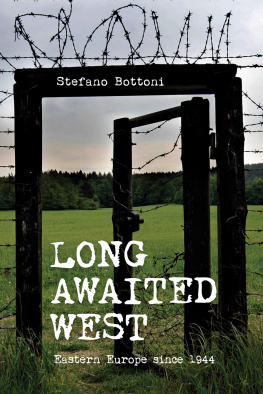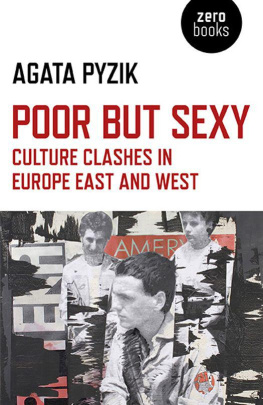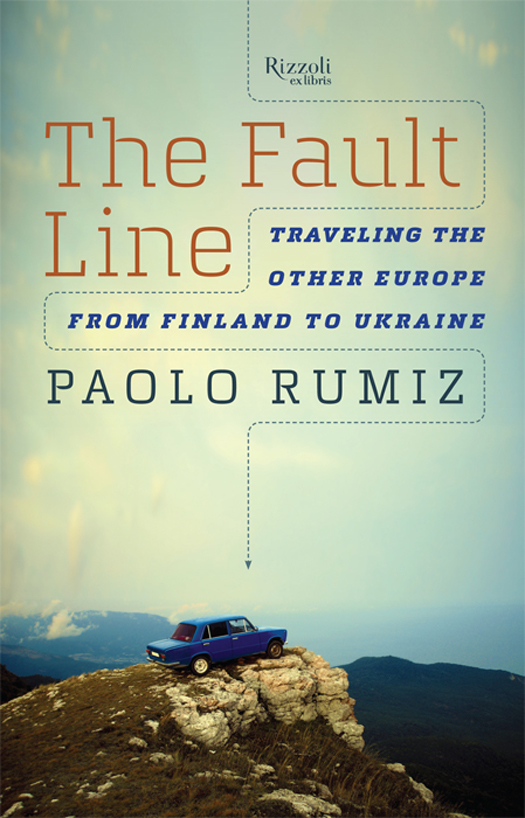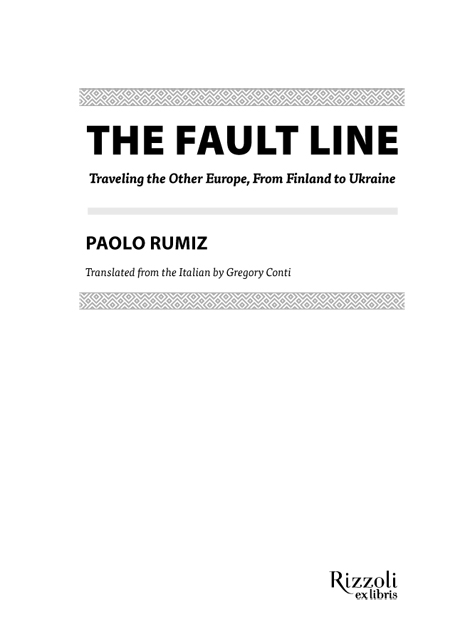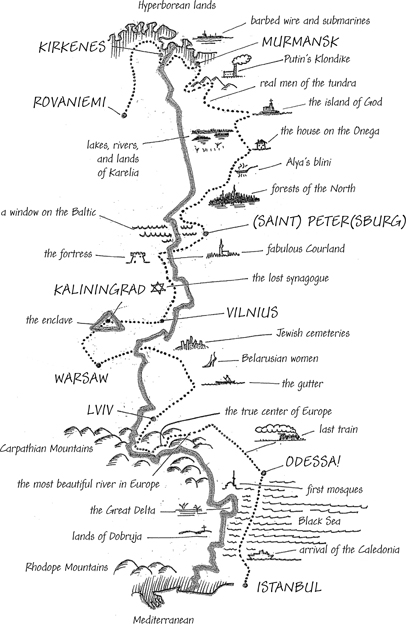Praise for The Fault Line
Theres an unlikely poetic beauty to his flowery, indulgent prose, in which every moment takes on transcendent meaning He lovingly describes his escapades and experiences, conjuring up places few tourists ever visit, exposing the dichotomy between the modernity of the EU and the time-lost ways of the old world, and illuminating a much-overlooked region of the world in a thoroughly fascinating manner. Theres no denying the allure and appeal of his European odyssey.
Publishers Weekly
A richly detailed journey into Europes dark past and vulnerable present.
Kirkus Reviews
Rumiz reveals his strength in his travels, in the journey that slowly builds up as each and every page is turned. It would be difficult to find another writer who is as well-equipped to adapt and enter into the world that he is passing through with such simplicity.
Il Mattino newspaper
[B]eautiful writing suffused with shadows and sun, bathed in love and melancholia, steeped in delicate and powerful fragrances.
Le Figaro newspaper
First published in hardcover in the United States of America in 2015
by Rizzoli Ex Libris, an imprint of
Rizzoli International Publications, Inc.
300 Park Avenue South
New York, NY 10010
www.rizzoliusa.com
Originally published in Italy as Trans Europa Express
Copyright 2012 by Paolo Rumiz
Published by arrangement with Marco Vigevani & Associati Agenzia Letteraria
Translation copyright 2015 Gregory Conti
This ebook edition 2015 Paolo Rumiz
All rights reserved. No part of this publication may be reproduced, stored in a retrieval system, or transmitted in any form or by any means, electronic, mechanical, photocopying, recording, or otherwise, without prior consent of the publishers.
ISBN-13: 978-0-8478-4545-3
v3.1
Contents
Preface
You always go back to the scene of the crime. I suppose thats why on a rainy day in January 2014, I set out again for the land of rivers, lakes, and forests that I had traveled through six years earlier on my unforgettable vertical journey along the eastern border of the European Union. To blame for my return was the First World War. One hundred years had passed since it began, and I had realized in amazement that the line of its endless Eastern Front coincided in many placesthe Baltic countries, Masuria, Ukrainewith my 2008 itinerary. The conclusion was almost automatic: the frontier of the European Union was not only located in the heart of Europe; it was also on a ruinous fault line.
Now, because earthquakesincluding those of the geopolitical varietytend to strike repeatedly in the same places, that long-term historical perspective inevitably consolidated the intuition expressed at the time I wrote this book, that a new Iron Curtain was forming, a few hundred kilometers east of the old one, which had collapsed in 1989. It now seemed even more plausible that countries like Ukraine, still Austro-Hungarian in the west and Russian in the east, were destined to be split in two, with grave consequences for the peace of the continent and the internal equilibrium of the Union.
This was confirmed by the events of 2014 in Kiev and its surroundings. By pure coincidence, the Ukrainian revolt exploded right before my eyes during my return to the Carpathians, changing all my perceptions. From then on, it was no longer possible to limit myself to the past, because the force of events obliged me to look at the present. Everything started to fit together like a puzzle. What I saw, for example, in the freezing-cold train station in Lviv, beyond the Carpathians, matched what I had been told in 2008, almost as a prophecy, by the student Maxim at the station in Khmelnytsky. A new conflict was in the offing, the country was on the verge of implosion.
Unlike my original vertical journey, my return to those places took the more banal form of a horizontal trip along the east-west axis of the great European roads, the rail lines, and the historic routes of armies. My aim was to verify, by navigating along the parallels, the findings I had made during that earlier extraordinary north-south core sampling. But the means of penetration remained the same: public transportation, particularly trains. They were not only a means for reliving the troop movements toward the front in 1914; they were also a good seismograph of the present. To understand which way the world is heading, you have to go to train stations, not to airports. But because diplomats prefer airports, their governments are no longer capable of foreseeing events.
I started out from Hungary, my staging area. There I sniffed the scent of a landlocked nation, proudly shut in on itself and haunted by claustrophobic nightmares. Budapest, nebulous in the endless Pannonian night, was the oversize head of a country whose body was reduced to its minimum dimensions a hundred years ago by the cynicism of Western politics. I remembered the solidity of the housesstill Hapsburgianand its grandiose architecture, more monumental than Viennas. Everywhere I looked, what came afterward was nothing more than a miserable crust. Everything indicated that 1914 had marked the beginning of a great unhappiness, which still endured today. Anti-Semitism was fatally reemerging, and peoples minds were focused on the past. Politicians couldnt stop haranguing against the injustice of Versailles, the peace treaty that had deprived the country of two thirds of its territory.
The only way back to Ukraine was the night train for Moscow, a noble, snail-paced convoy of sleeping cars, which at the border with the former Soviet empire still had to stop, as it did in Brezhnevs time, to adapt the cars to the different gauge of the Eastern tracks. The instant I boarded, I felt as though I had entered a magnificent time machine. We headed into the pitch-dark plain, and from then on, everything became diluted and unfathomable. I saw armies marching blindly, searching for the enemy in the immense void of the steppe. The exact opposite of the Western Front, immobile in the trenches, concentrated in a narrow strip only a few miles wide. The Eastern Front was still the land of the Scythians and the Budini, the ancestors of the Slavs, whom the Persian emperors Cyrus and Darius had vainly attempted to rout on the boundless plains around the Black Sea.
I noticed that the Russian train personnel were gruff with foreigners and especially with the conductor of the only Ukrainian sleeping car. The reason was immediately clear to me: Kiev had seen the first incidents of street fighting that would shortly brew into a revolt, with people dead and wounded. The news was already racing from mouth to mouth; it had arrived on the wire of those cars and those tracks. Down at the end of the corridor, the conductor of our sleeping car was busy making tea in the samovar on the coal-fired stove, and I was reading the notes made by the soldiers on their way to the front: Its all mud, mud, mud. Mud in the water, in the air, on the roads, in the pastures, in the fields, everywhere. Even the people look as though theyre made of mud.



